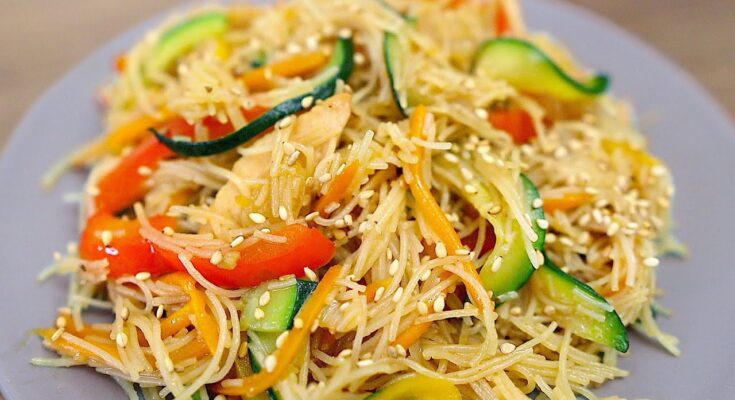Rice Noodle Recipe: Craving a satisfying meal that’s both light and packed with flavor? Look no further than rice noodles.
Whether you’re new to the kitchen or a seasoned home cook, rice noodles offer a quick, flexible, and delicious base for a variety of dishes.
From stir-fries to soups and salads, this step-by-step guide will help you master the art of cooking perfect rice noodles every time. Ready to dig in?
What Are Rice Noodles?
Rice noodles are thin or wide strips made primarily from rice flour and water. Common in Asian cuisines, especially Thai, Vietnamese, and Chinese dishes, they’re naturally gluten-free and have a mild, delicate flavor. Unlike wheat noodles, rice noodles have a soft, chewy texture when cooked correctly, making them ideal for soaking up the flavors of sauces and broths.
There are various types of rice noodles, including:
- Vermicelli (thin noodles)
- Pad Thai noodles (medium-width)
- Wide rice noodles (used in stir-fries like Pad See Ew)
Each type has its unique texture and cooking requirements, but the core ingredient base remains the same.
Popularity and Origins of Rice Noodles
Rice noodles trace their roots back to China over 2,000 years ago. Due to the widespread cultivation of rice in Southern China and Southeast Asia, noodles made from rice became a staple. Today, rice noodles have traveled the globe and become an essential part of many fusion dishes.
From pho in Vietnam to pad Thai in Thailand, rice noodles are known for absorbing sauces well while remaining light and easy to digest. Their versatility has made them a go-to option for anyone looking to whip up a quick, flavorful, and healthy meal.
Ingredients Needed for Rice Noodle Recipe
Core Ingredients
Before diving into the cooking process, let’s talk about what you’ll need. A good rice noodle dish starts with a few staple ingredients:
- Rice Noodles (dried or fresh): Choose based on your preferred thickness.
- Oil: Vegetable, sesame, or peanut oil work great for stir-frying.
- Garlic and Onion: For aromatic depth.
- Soy Sauce or Tamari: Adds umami flavor.
- Protein: Chicken, shrimp, tofu, or beef—totally your call.
- Vegetables: Bell peppers, carrots, bean sprouts, bok choy, broccoli.
These basics will build the foundation of your dish, allowing you to tailor the flavors to your taste.
Optional Add-ons for Extra Flavor
Want to take it to the next level? Add some of these ingredients for extra oomph:
- Ginger: Freshly grated for a zingy kick.
- Chili flakes or Sriracha: For some heat.
- Oyster Sauce or Hoisin Sauce: For a deeper savory taste.
- Lime Juice: For a zesty finish.
- Fresh Herbs: Cilantro, Thai basil, or green onions.
- Peanuts: Crushed for a crunchy topping.
These optional ingredients make a huge difference and let you explore flavors from Thai to Chinese and even fusion-style rice noodle dishes.
Step-by-Step Guide to Cooking Rice Noodles
Step 1: Boiling or Soaking the Noodles
Rice noodles require a gentle touch. Unlike pasta, they don’t need to be boiled aggressively. Here’s how to prep them:
- For dried noodles: Soak in warm water for 20-30 minutes until soft. If the package says to boil, do it for just 3-4 minutes.
- For fresh noodles: A quick dip in hot water or a light stir-fry will do.
Pro tip: Don’t overcook them! They’ll go mushy fast. Once softened, rinse them under cold water to stop the cooking process and set them aside.
Step 2: Prepping Vegetables and Proteins
While the noodles are soaking, prepare your veggies and proteins. Slice everything thin so it cooks quickly and evenly:
- Veggies: Julienne carrots, thinly slice bell peppers, shred cabbage.
- Proteins: Cut chicken or tofu into bite-sized pieces. Marinate with soy sauce, garlic, and a pinch of sugar for added flavor.
Stir-frying is fast, so having everything prepped in advance ensures nothing burns and all ingredients are cooked to perfection.
Step 3: Stir-Frying and Mixing
Now it’s time to bring it all together:
- Heat oil in a wok or large skillet over medium-high heat.
- Add garlic and onions first. Stir for 30 seconds until fragrant.
- Toss in protein and cook thoroughly (3-5 minutes).
- Add veggies and cook for 2-3 minutes until tender-crisp.
- Add the soaked rice noodles and gently mix.
- Pour in your sauces (soy, oyster, hoisin, etc.) and stir to coat everything evenly.
- Cook for 2-3 minutes until noodles absorb the sauce.
Tip: Use tongs to mix gently—rice noodles are delicate!
Tips for Perfect Rice Noodles Every Time
Common Mistakes to Avoid
- Overcooking the noodles: They become soggy and break apart.
- Too much sauce: Rice noodles absorb flavors quickly. Start small and add more gradually.
- Skipping the rinse: After cooking, rinsing stops them from sticking together.
Enhancing Flavor and Texture
- Use high heat when stir-frying to create that slight “charred” flavor.
- Add sauces in stages to control flavor intensity.
- For extra depth, throw in a splash of broth or fish sauce.
Making rice noodles isn’t hard, but a few smart tweaks can make your dish go from good to unforgettable.
Customizing Your Rice Noodle Dish
Making It Vegan or Vegetarian
One of the greatest things about rice noodles? They’re incredibly easy to adapt to plant-based diets. If you’re vegan or vegetarian, you can still enjoy all the flavor without compromising your lifestyle. Here’s how to tweak the recipe:
- Protein substitutes: Use tofu, tempeh, or seitan. Tofu especially works great when pan-fried until golden and crispy.
- Sauce check: Make sure your soy sauce, hoisin sauce, or any packaged sauce is vegan (some may contain fish sauce or animal-based additives).
- Add veggies: Boost the dish with mushrooms, spinach, zucchini, snow peas, or eggplant for more body and flavor.
- Add umami: A dash of mushroom soy sauce or a sprinkle of nutritional yeast can replicate that rich umami flavor typically provided by meat.
The best part? You won’t miss the meat at all. The textures, colors, and layered flavors in a vegan rice noodle dish can be even more exciting than the traditional version.
Spice Levels and Sauces
The magic of rice noodles is in the sauce—and everyone’s spice tolerance is different. Whether you love a little heat or want your taste buds on fire, here are ways to adjust:
- Mild: Stick with soy sauce, garlic, and a splash of lime. No chili, no problem.
- Medium: Add sriracha or a few red pepper flakes.
- Spicy: Bring in Thai bird chilies, chili oil, or sambal oelek.
- Extreme: Homemade chili paste or a spoonful of ghost pepper sauce if you dare.
For sauce lovers, here are some flavor combos to try:
- Sweet and Savory: Hoisin sauce + soy sauce + a pinch of brown sugar
- Zesty and Fresh: Lime juice + garlic + fish sauce + chili flakes
- Peanut Style: Peanut butter + soy sauce + sesame oil + garlic + water (for a creamy blend)
Don’t be afraid to mix and match to find the perfect blend that hits all the right notes for you.
Serving and Presentation Ideas
Plating for the Wow Factor
Let’s be real—your rice noodle dish can taste amazing, but a good presentation takes it to the next level. Here’s how to make your plate Instagram-worthy:
- Use a wide, shallow bowl or plate: This makes it easier to arrange the noodles and toppings aesthetically.
- Layer smart: Start with noodles, then top with colorful veggies and proteins.
- Garnish generously: Crushed peanuts, chopped scallions, fresh cilantro, lime wedges, and sesame seeds not only look beautiful but add texture and flavor too.
- Drizzle effect: A zigzag of sauce over the top? Chef’s kiss.
If you’re entertaining guests or just treating yourself, a beautifully presented dish turns a regular meal into a gourmet experience.
Perfect Pairings with Rice Noodles
Not sure what to serve with your noodles? Try these tasty sides and drinks:
Sides:
- Spring rolls or egg rolls
- Cucumber salad with sesame dressing
- Steamed or pan-fried dumplings
- Pickled veggies for contrast
Drinks:
- Thai iced tea or iced coffee
- Sparkling water with lime
- Jasmine green tea
- Light white wine or sake (for adults)
Pairing enhances the overall meal and creates a full dining experience that feels like your favorite restaurant, right at home.
Making Rice Noodles Ahead of Time
Meal Prep and Storage Tips
Got leftovers? Or maybe you’re cooking in bulk for the week. Rice noodles can be meal-prep friendly with the right approach:
- Storage: Keep the noodles and toppings separate in airtight containers. Combine just before reheating to avoid sogginess.
- Shelf life: Cooked rice noodles last 3-4 days in the fridge. Use a bit of oil before storing to prevent them from sticking together.
- Freezing: It’s not recommended to freeze rice noodles as they often get mushy when thawed. However, you can freeze the protein and sauce separately.
Reheating tip: Use a skillet or microwave with a splash of water or broth. Avoid overcooking again during reheating to maintain that ideal texture.
Quick-Fix Lunch Ideas Using Leftovers
Your leftovers don’t have to be boring. Transform them with a few tweaks:
- Noodle salad: Toss cold rice noodles with sesame oil, vinegar, veggies, and tofu for a refreshing lunch.
- Soup bowl: Add leftover noodles to hot broth with greens and a soft-boiled egg.
- Noodle wrap: Roll the noodles and fillings into lettuce or rice paper for a fun twist.
With a little creativity, your rice noodle leftovers can feel like an entirely new meal—fast, fresh, and satisfying.
Nutritional Benefits of Rice Noodles
Why Rice Noodles Are a Healthy Option
If you’re trying to eat healthier or just want a meal that doesn’t weigh you down, rice noodles are an excellent option. Here’s why they’re worth a spot on your plate:
- Gluten-Free: Made from rice flour, these noodles are naturally free of gluten, making them perfect for those with gluten intolerance or celiac disease.
- Low in Fat: Rice noodles contain virtually no fat on their own, which means you can control the fat content by how you prepare the dish.
- Quick Energy: High in carbohydrates, rice noodles are great for giving you that quick energy boost without the heaviness of pasta.
- Easy to Digest: Their simple composition means your body can process them more easily, making them a great choice for sensitive stomachs.
While rice noodles might not offer as much protein or fiber as whole wheat options, they make up for it with their versatility. Add the right veggies and protein, and you’ve got a well-rounded, nutritious dish.
Comparing Rice Noodles to Other Noodles
Let’s stack rice noodles up against other common types:
| Type of Noodle | Gluten-Free | Calories (per cup) | Texture | Cooking Time |
|---|---|---|---|---|
| Rice Noodles | Yes | 190 | Soft, Chewy | 5-7 mins |
| Egg Noodles | No | 210 | Rich, Firm | 8-10 mins |
| Soba Noodles | Sometimes | 113 | Nutty, Springy | 6-8 mins |
| Udon Noodles | No | 210 | Thick, Chewy | 10-12 mins |
| Zucchini Noodles | Yes | 20 | Crunchy | 1-2 mins |
Rice noodles hold their own as a light, gluten-free alternative that fits beautifully into many Asian-inspired meals.
Common Mistakes to Avoid When Cooking Rice Noodles
Avoiding Sticky or Soggy Noodles
One of the biggest mistakes people make with rice noodles is cooking them like wheat pasta. Here’s what not to do:
- Overcooking: Rice noodles don’t need boiling in most cases—just a good soak. Too much heat, and they’ll turn mushy.
- Skipping the rinse: Always rinse the noodles with cold water after cooking. It halts the cooking process and prevents clumping.
- Not oiling them: Toss the noodles in a little oil if you’re not using them immediately. It helps them stay separated.
Also, don’t forget that rice noodles keep cooking even after you take them off the heat—carryover heat is real!
Sauce-to-Noodle Ratio Mistakes
It’s tempting to drown your noodles in sauce, but that’s a fast track to a gloopy mess. Here’s the key:
- Start small: Add half the sauce, toss, taste, and then decide if you need more.
- Thin sauces work better: A watery soy-based sauce coats more evenly than thick peanut or hoisin sauces.
- Layer flavors: Use a bit of sauce in the stir-fry and save some for a drizzle at the end for maximum flavor.
Finding that perfect sauce-to-noodle balance can turn your dish from decent to divine.
Exploring Global Rice Noodle Dishes
Famous International Recipes
Rice noodles are a star in many international kitchens. Let’s take a quick culinary tour:
- Pad Thai (Thailand): Stir-fried rice noodles with egg, tofu, shrimp, peanuts, and a sweet-savory tamarind sauce.
- Pho (Vietnam): A soul-soothing noodle soup made with beef or chicken broth, herbs, and rice noodles.
- Char Kway Teow (Malaysia): Flat rice noodles stir-fried with egg, shrimp, Chinese sausage, and dark soy sauce.
- Chow Fun (China): Wide rice noodles stir-fried with beef and bean sprouts in a savory soy-based sauce.
- Singapore Rice Noodles: Though ironically not from Singapore, this curry-flavored stir-fry with thin vermicelli is a Chinese takeout classic.
Each of these dishes highlights the flexibility and adaptability of rice noodles in different cultures and cooking styles.
Creative Fusion Ideas with Rice Noodles
Want to go off the beaten path? Try these fusion concepts:
- Rice Noodle Tacos: Use lettuce or rice paper as shells, fill with spicy rice noodles, and top with slaw.
- Rice Noodle Buddha Bowl: Mix noodles with roasted veggies, greens, edamame, and sesame dressing.
- Noodle Stir-Fry Pizza: Press rice noodles into a skillet to form a “crust,” top with stir-fry veggies and bake for a fun twist.
Let your imagination run wild. Rice noodles are like a blank canvas waiting to be transformed.
FAQs about Rice Noodle Recipe
What type of rice noodles work best for this recipe?
The beauty lies in your preference! Thin, vermicelli-style noodles are perfect for light, brothy dishes, while wider, flat noodles champion heartier meals with robust sauces. Experiment to discover your noodle nirvana!
Do I need to pre-soak rice noodles before cooking?
Absolutely. Soaking rice noodles is crucial to achieve that delightful, springy texture without them turning into a mushy disaster. Just follow the package instructions for the best results—usually a warm water soak does the trick.
Can I add protein to my rice noodle dish?
Go for it! Chicken, shrimp, tofu, or beef can elevate your noodle dish from simple to sublime. Make sure to cook your protein choice properly before tossing it into the mix.
What are the best vegetables to add to rice noodles?
Crunch and color are your friends here. Bell peppers, snap peas, carrots, and green onions add texture and vibrant hues. For a greener touch, spinach or bok choy can be delightful.
Is there a gluten-free option for rice noodles?
Rice noodles are naturally gluten-free, making them a fantastic option for those avoiding gluten. Just ensure other ingredients like sauces are gluten-free too!
How can I store leftover rice noodle dishes?
Cool your dish completely before storing it in an airtight container. It’ll stay fresh in the refrigerator for up to three days. Reheat gently, adding a splash of water to revive the noodles.
Are there any tips for making the perfect rice noodle dish?
Patience is key! Don’t overcook your noodles—keep them al dente. And remember, rice noodles love dressing up in sauces, so be generous but balanced to coat every strand perfectly.
Conclusion
Rice noodles are more than just a delicious pantry staple—they’re a gateway to endless culinary creativity. Whether you want a quick 15-minute lunch, a fancy dinner for friends, or a nourishing vegan bowl, rice noodles can do it all. With their fast cook time, gluten-free benefits, and ability to soak up bold flavors, they deserve a top spot in your weekly meal rotation.
Now that you’ve got the step-by-step down, the flavor combos in mind, and some global inspiration, it’s time to get cooking. Don’t be afraid to experiment. Make it spicy, make it sweet, or make it your own—rice noodles are incredibly forgiving and oh-so-satisfying.



